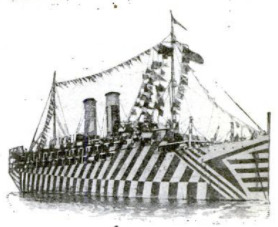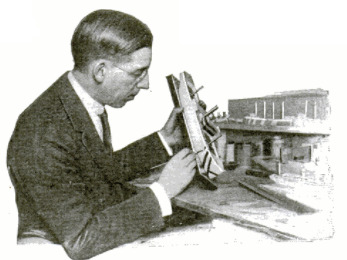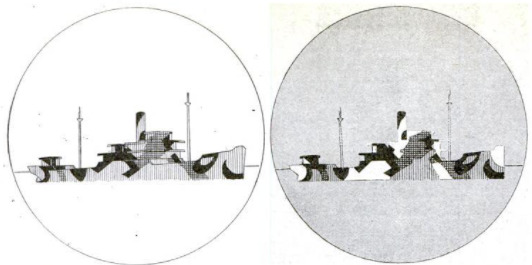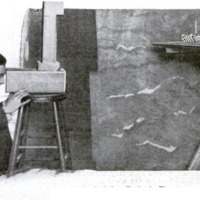-
Title (Dublin Core)
-
The important role played by British and U. S. artists in the improvement of comouflage systems for ships
-
Article Title and/or Image Caption (Dublin Core)
-
Title: Fighting the U-Boat with Painting
-
Subtitle: How American and English artists taught sailors to dazzle the U-boat
-
extracted text (Extract Text)
-
ROBIN HOOD was a camoufleur.
Like all huntsmen from time
immemorial, he wore green, so
that he would blend in color with the
foliage of the forest. He must have
been all but invisible when he stood
stock-still. Naval officers would say,
in their technical parlance, that his
visibility was low.
There never was a time, in the his-
tory of warfare, when similar camou-
flaging was not practised in a crude
yet effective way for the purpose of
concealment. Julius Caesar knew the
value of low visibility; for he gave
orders that the ships that bore him -
to Britain should be painted green and
that his sailors should wear green.
‘The Romans camouflaged their ships
when they went out to suppress
troublesome Mediterranean pirates.
And’ the seafaring Danes, too, long
before the Christian era, tied
boughs to their masts and lurked
in forest-fringed bays to mislead
their naval foes i
Battleships have been painted a
dull slate-gray for a generation, to
‘make them less conspicuous; but it
is doubtful if their visibility was ever
aslowasthat of the camouflaged ships
of the ancient Romans and Danes.
At all events, we know now that
battleship paint was neither properly
selected nor scientifically applied.
Artists to the Rescue
‘When the German U-boats began their
depredations, it became desperately
necessary to provide some protective
coloration for transports, food-ships,
and the hundreds of vessels that were
carrying munitions to Europe.
‘Battleship gray having proved utterly
useless, naval officers turned instine-
tively to artists for advice and assis-
tance. If an artist, with his trained
eye, knows how to apply color, knows
how to trace lines on canvas so that
they become the counterfeit present-
ment of the thing he sees, couldn't
he reverse the process and devise
some way of blotting out the thing
to be looked at?
It s0 happened that American art-
ists interested themselves in devising
schemes of protective coloration as
soon as the U-boat began to sink on
sight. The pioneers among them were
William Andrew Mackay, Maximilian
Toch, Gerome Brush, E. L. Warner,
and Louis Herzog.
These artists relied almost entirely
on their experience as observers of
nature and colorists; no attempt was
made at first to approach the subject
Standardizing Marine
Camouflage .
In1917the Submarine Defense
Association was formed for the
purpose of laying down the
principles of marine camouflage
and standardizing them as far
as possible. The association was
composed of nearly a hundred
leading American and British
shipping and export companies
and all the leading marine
insurance firms. Lindon W.
Bates was made chairman of the
Engineering Committee, and
through him Mr. George East-
man became interested to such
an extent that the resources of the
Kodak Laboratory were placed at the
commistee’s disposal so that camouflage
could be studied scientifically.
The first inkling that ship-owners and
the general public received that the ap-
parently crazy splashes of paint and
the freakish stripes that adorned the
smokestacks, superstructure, and hulls
of ships were not the whimsical color
schemes of half-demented cubists and
futurists, but very carefully thought
out systems of protection, came in an
order from the War Risk Insurance
Board to the effect that ships not
camouflaged according to the principles
laid down by Mackay, Brush, Herzog,
Toch, and Warner would have to pay a
higher premium for marine insurance.
The committee provisionally accepted
the work of these five men as a basis,
and then proceeded tostudy camouflage
not from the artistic but solely from a
dispassionate scientific point of view.
U-Boat Commanders Baffled
For a time low-visibility coloration
baffled the U-boat commanders. It
had its limita-
tions. Effective
enough at dis-
tances of 5,000 yards or more, it failed |
to protect at shorter ranges. More-"
over, U-boat commanders were not
dependent on their eyes alone; their
craft were equipped with microphone
sound-detectors—sensitive instruments
that made audible the beating of dis-
tant propellers, the thumping of en-
gines, the thousand and one murmurs,
raspings, and clankings of a laboring
ship. Even if the U-boat captains
eyes were momentarily fooled, his
electrical ears were hearing.
Then it was that Mr. Mackay and |
Commander Norman Wilkinson, the
distinguished English marine artist,
independently began to experiment |
with the idea of throwing the U-boat |
commander off the track.
The man at the periscope has to sight
and to take very careful bearings be- |
fore he can plant a torpedo success-
fully. He launches his torpedo at a |
range of less than a mile, as a rule. |
Is it not possible to fool him as to the
direction in which the ship is heading,
or as to the part of the hull at which
he is looking? That is the underlying
principle of what is known as the
“dazzle” system. It is now combined
with the low-visibility system; for
low visibility has advantages
at ranges of more than 5,000
yards.
The ** Dazzle” System
The dazzle system is really
an evolution of the low-visibility
system. It was discovered that,
while large patches of color
serve to break up the char-
acteristic lines of a ship, smaller
patches are even more effective.
Small patches, in turn, sug-
gested stripes, and striping is
the basis of some “dazzle” for-
mulas. Low-visibility painting
and dazzle painting are really
antagonistic in principle. The
one is most effective at long
ranges, the other at short ranges.
Low visibility is of primary import-
ance; dazzle painting is of use only
at fairly close quarters after low visi-
bility has failed. Low visibility is in-
tended to prevent an attack from being
made at all—the dazzle system to pre-
vent the attack from being successful
Low visibility is always of primary im-
portance, because it complicates the
U-boat’s task.
Suppose an uncamouflaged ship is
visible at 15,000 yards. Skilful camou-
flaging will enable her to approach the
seeing eye to within 5,000 yards
without increasing her visibility, In-
terpret this fact in terms of the sub-
marine. It means that more U-boats
must patrol a given area traversed by
camouflaged than by uncamouflaged
ships.
The area of a circle varies as the
squares of the radius. Hence, if a
camouflaged ship can steam safely at
a distance of 5,000 yards and an un-
camouflaged ship only at a distance of
15,000 yards, the area that a U-boat
can effectively patrol is only one ninth
as great if it is hunting for ships of
low visibility. Nine submarines must
patrol the area that could otherwise
be covered by one. On the whole,
more reliance is placed on the attain:
ment of low visibility than on dazzling
painting.
But, at Teast, dazzling the U-boat
commander has this advantage. If
he does not score a hit, he is sure to
be run down or sunk by gun-fire when
he comes up to find out whether or not
he wassuccessful. He betrays himself.
What Constitutes “Appearance” >
Look at that horsé walking down the
street. You recognize him at once as
a horse, even though he is a quarter
of a mile away. And why? Because
of his general appearance, you say.
But what constitutes “appearance”?
Form and very little else—a peculiar
arrangement of lines, curves, and
angles. If you paint a picture of him
you sketch on your canvas these lines,
curves, and angles.
Out at sea is a ship. Like every-
thing else in the world, she is to the
eye a combination of lines and angles.
In which direction is she heading?
North-northwest, you say. How do
youknow? You judgethe course chiefly
by the motion of the superstructure,
a thing that bears a certain angular
relationship to the hull. Destroy these
angles, or substitute others for them.
The angles by which we judge rela-
tive motion are not those to which
our eyes have been accustomed; the
ship seems to be heading in a direc- |
tion that is not her real course.
Look at such a ship through the
periscope, and you will be dazzled—
dazzled not in the sense that you
find it painfully difficult to see, but
in the sense that you are deceived. An
error of a few degrees in course, of two
knots in speed, or of two hundred to
three hundred yards in range is enough
to throw out the aim of the man who
gives the signal to launch a torpedo.
Tt was the task of the Submarine
Defense Association to determine
whether low visibility was better than
dazzle, or vice versa; whether low
visibility should be combined with
dazzle or-not; and how the different
low visibility systems compare with
one another and likewise the different
dazzle systems.
Scientific research proved that every
dazzle system surrenders something fo
visibility. How much may thus be
safely sacrificed in order to throw out
the torpedo can be determined only af-
ter along and patient scientific investi-
gation. It seems certain, however, that
dazzle painting on bows, funnels, and
‘masts is very effective, the result being
a confused pattern which usually de-
ceives as to course, range, and speed.
Enter the Scientist
The first scientific study of marine
camouflage has been made by Mr.
Lloyd Jones, of the Eastman Kodak
Laboratory. He invented a visibility
meter in order to pursue his investi-
gations. His dispassionate examina-
tion shows whether or not the particu-
Tar shade of violet or green selected
is scientifically the best, or how
one dazdle: vation comuares with
another, The artist,
having laid the foun
dation, gracefully re- |
tires and leaves the |
refining of marine
camouflage to the |
physicist.
-
Contributor (Dublin Core)
-
Waldemar Kaempffert (Article writer)
-
Language (Dublin Core)
-
eng
-
Date Issued (Dublin Core)
-
1919-04
-
pages (Bibliographic Ontology)
-
17-19
-
Rights (Dublin Core)
-
Public domain (Google digitized)
-
Archived by (Dublin Core)
-
Davide Donà
-
Marco Bortolami (editor)
 Popular Science Monthly, v. 94, n. 4, 1919
Popular Science Monthly, v. 94, n. 4, 1919












